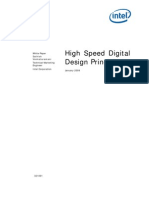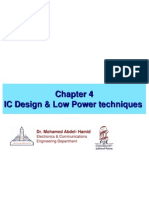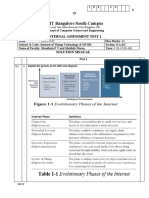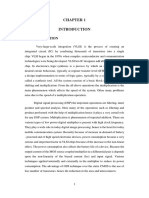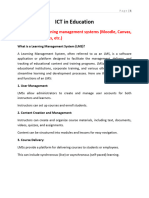Chapter 1 - Introduction To Digital System Design
Chapter 1 - Introduction To Digital System Design
Uploaded by
Văn Nguyễn CôngCopyright:
Available Formats
Chapter 1 - Introduction To Digital System Design
Chapter 1 - Introduction To Digital System Design
Uploaded by
Văn Nguyễn CôngOriginal Description:
Original Title
Copyright
Available Formats
Share this document
Did you find this document useful?
Is this content inappropriate?
Copyright:
Available Formats
Chapter 1 - Introduction To Digital System Design
Chapter 1 - Introduction To Digital System Design
Uploaded by
Văn Nguyễn CôngCopyright:
Available Formats
HCMC University of Technology and Education
Faculty of Electrical & Electronic Engineering
No.1 Vo Van Ngan Street, Thu Duc Dist., HCMC, VN
DIGITAL IC DESIGN
USING HDL
NGUYEN THANH NGHIA
9/27/2021 11
NGUYEN THANH NGHIA
Administration
1. Instructor: Thanh-Nghia Nguyen.
Mail: nghiant@hcmute.edu.vn
https://sites.google.com/a/hcmute.edu.vn/thanh-nghia-nguyen/
Facebook: BMDTCNYS-DHSPKT
Faculty: http://feee.hcmute.edu.vn
2. Textbook: RTL HARDWARE DESIGN
USING VHDL - PONG P.CHU.
NGUYEN THANH NGHIA 2
Administration
3. Grading:
Midterm : 50%
o Online
o Paper Test
o Project
o Attending
Final Exam: 50%
4. Syllabus.
NGUYEN THANH NGHIA 3
Administration
5. File name: hovaten_TuanX.rar
6. Deadline: .
NGUYEN THANH NGHIA 4
HCMC University of Technology and Education
Faculty of Electrical & Electronic Engineering
No.1 Vo Van Ngan Street, Thu Duc Dist., HCMC, VN
CHAPTER 1:
INTRODUCTION TO
DIGITAL SYSTEM DESIGN
NGUYEN THANH NGHIA
9/27/2021 55
NGUYEN THANH NGHIA
Outline
1. Introduction.
2. Device Technologies.
3. System Representation.
4. Comparison of Technologies
5. Levels Of Abstraction.
6. Development Tasks And Eda Software.
NGUYEN THANH NGHIA 6
Chapter 1: Introduction to Digital System Design
1. Introduction
Digital hardware has experienced drastic
expansion and improvement in the past 40 years.
The number of transistors in a single chip has
grown exponentially.
NGUYEN THANH NGHIA 7
Chapter 1: Introduction to Digital System Design
1. Introduction
A silicon chip now routinely contains
hundreds of thousands or even hundreds of
millions of transistors.
NGUYEN THANH NGHIA 8
Chapter 1: Introduction to Digital System Design
1. Introduction
In the past, the major applications of digital
hardware were computational systems.
However, as the chip became smaller,
faster, cheaper and more capable, many
electronic, control, communication and even
mechanical systems have been “digitized”
internally, using digital circuits to store,
process and transmit information.
NGUYEN THANH NGHIA 9
Chapter 1: Introduction to Digital System Design
1. Introduction
As applications become larger and more
complex, the task of designing digital circuits
becomes more difficult.
Developing and producing a digital circuit
is a complicated process, and the design and
synthesis are only two of the tasks.
The best way to handle the complexity is to
view the circuit at a more abstract level and
utilize software tools to derive the low-level
implementation.
NGUYEN THANH NGHIA 10
Chapter 1: Introduction to Digital System Design
1. Introduction
e.g, digital circuit in a wireless communication
system transmitter
A Error
Data Data
info / correction Modulation
compression encryption
D coding
digital implementation
D Error
Data de- Data De-
info / correction
compression decryption modulation
A de-coding
digital implementation
receiver
NGUYEN THANH NGHIA 11
Chapter 1: Introduction to Digital System Design
1. Introduction
e.g, digital circuit in a control system
Sen
A D sor
actu
/ Controller / Plant
ator output
D A
set point digital
implementation
NGUYEN THANH NGHIA 12
Chapter 1: Introduction to Digital System Design
1. Introduction
Why Digital
• Advantage of digital devices
• Reproducibility of information
• Flexibility and functionality: easier to store, transmit and
manipulate information
• Economy: cheaper device and easier to design
• Moore’s law
• Transistor geometry
• Chips double its density (number of transistor) in every 18
months
• Devices become smaller, faster and cheaper
• Now a chip consists of hundreds of million gates
• And we can have a “wireless-PDA-MP3-player-
camera-GPS-cell-phone” gadget very soon
NGUYEN THANH NGHIA 13
Chapter 1: Introduction to Digital System Design
2. Device Technologies: Fabrication of an IC
If we want to build a custom digital system,
there are varieties of device technologies to
choose.
There is no single best technology.
We have to consider the trade-offs among
various factors, including chip area, speed,
power and cost.
NGUYEN THANH NGHIA 14
Chapter 1: Introduction to Digital System Design
2. Device Technologies: Fabrication of an IC
To better understand the differences between
the device technologies, it is helpful to have a
basic idea of the fabrication process of an
integrated circuit (IC).
An IC is made from layers of doped silicon,
poly silicon, metal and silicon dioxide, built
on top of one another, on a thin silicon wafer.
Some of these layers form transistors, and
others form planes of connection wires.
NGUYEN THANH NGHIA 15
Chapter 1: Introduction to Digital System Design
2. Device Technologies: Fabrication of an IC
To better understand the differences between
the device technologies, it is helpful to have a
basic idea of the fabrication process of an
integrated circuit (IC).
An IC is made from layers of doped silicon,
poly silicon, metal and silicon dioxide, built
on top of one another, on a thin silicon wafer.
Some of these layers form transistors, and
others form planes of connection wires.
NGUYEN THANH NGHIA 16
Chapter 1: Introduction to Digital System Design
2. Device Technologies: Fabrication of an IC
Transistors and connection are made from many layers
(typical 10 to 15 in CMOS) built on top of one another.
Each layer has a special pattern defined by a mask
• One important aspect of an IC is the length of a smallest
transistor that can be fabricated
• It is measured in micron (mm, 10-6 meter)
NGUYEN THANH NGHIA 17
Chapter 1: Introduction to Digital System Design
2. Device Technologies: Fabrication of an IC
Each layer has a special pattern defined by a mask
• E.g., we may say an IC is built with 0.50 mm process
• The process continues to improve, as witnessed by
Moore’s law
• The state-of-art process approaches less than
a fraction of 0.1 mm (known as deep sub-micron)
NGUYEN THANH NGHIA 18
Chapter 1: Introduction to Digital System Design
2. Device Technologies: Fabrication of an IC
NGUYEN THANH NGHIA 19
Chapter 1: Introduction to Digital System Design
2. Device Technologies: Classification of device technologie
Where customization is done.
• In a fab (fabrication facility): ASIC (Application
Specific IC)
• In the “field”: non-ASIC
Classification
• Full-custom ASIC
• Standard cell ASIC
• Gate array ASIC
• Complex field programmable logic device
• Simple field programmable logic device
• Off-the-shelf SSI (Small Scaled IC)/MSI (Medium
Scaled IC) components.
NGUYEN THANH NGHIA 20
Chapter 1: Introduction to Digital System Design
2. Device Technologies: Full-custom ASIC
All aspects (e.g., size of a transistor) of a
circuit are tailored for a particular application.
Circuit fully optimized
Design extremely complex and involved
Only feasible for small components
Masks needed for all layers
http://www.csitsun.pub.ro/resources/asic/CH01.pdf
NGUYEN THANH NGHIA 21
Chapter 1: Introduction to Digital System Design
2. Device Technologies: Full-custom ASIC
We have complete control of the circuit and
can even craft the layout of a transistor to
meet special area or performance needs.
The resulting circuit is fully optimized and
has the best possible performance.
NGUYEN THANH NGHIA 22
Chapter 1: Introduction to Digital System Design
2. Device Technologies: Full-custom ASIC
Unfortunately, designing a circuit at the
transistor level is extremely complex and
involved, and is only feasible for a small circuit
NGUYEN THANH NGHIA 23
Chapter 1: Introduction to Digital System Design
2. Device Technologies: Full-custom ASIC
It is not practical to use this approach to
design a complete system, which now may
contain tens and even hundreds of millions of
transistors.
The major application of
full-custom ASIC
technology is to design the
basic logic components that
can be used as building
blocks of a larger system.
NGUYEN THANH NGHIA 24
Chapter 1: Introduction to Digital System Design
2. Device Technologies: Full-custom ASIC
Another application is to design special-
purpose “bit- slice” typed circuits, such as a 1-
bit memory or 1-bit adder.
These circuits have a regular structured are
constructed through a cascade of identical slices.
The 8 input AND gate
NGUYEN THANH NGHIA 25
Chapter 1: Introduction to Digital System Design
2. Device Technologies: Standard-Cell ASIC
Circuit made of a set of pre-defined logic,
known as standard cells.
E.g., basic logic gates, 1-bit adder, D FF etc.
Layout of a cell is pre-determined, but layout
of the complete circuit is customized.
Masks needed for all layers.
NGUYEN THANH NGHIA 26
Chapter 1: Introduction to Digital System Design
2. Device Technologies: Standard-Cell ASIC
In standard-cell ASIC (also simply known as
standard-cell) technology.
A circuit is
constructed by
using a set of
predefined logic
components,
known as
standard cells.
NGUYEN THANH NGHIA 27
Chapter 1: Introduction to Digital System Design
2. Device Technologies: Standard-Cell ASIC
These cells are predesigned and their layouts are
validated and tested.
Standard-cell ASIC technology allows us to work
at the gate level rather than at the transistor level
and thus greatly simplifies the design process.
NGUYEN THANH NGHIA 28
Chapter 1: Introduction to Digital System Design
2. Device Technologies: Standard-Cell ASIC
The device manufacturer usually provides a
library of standard cells as the basic building
blocks.
The library normally consists of basic logic gates,
simple combinational components, such as:
an and-or-inverter.
2-to-1 multiplexer.
1-bit full adder.
NGUYEN THANH NGHIA 29
Chapter 1: Introduction to Digital System Design
2. Device Technologies: Standard-Cell ASIC
The basic memory elements, such as: a D-type
latch and, D-type flip-flop.
Some libraries
may also contain
more sophisticated
function blocks,
such as an adder,
barrel shifter and
random access
memory (RAM). D Flip Flop Using TRANSMISSION GATES
NGUYEN THANH NGHIA 30
Chapter 1: Introduction to Digital System Design
2. Device Technologies: Standard-Cell ASIC
In standard-cell technology, a circuit is made of
cells.
The types of cells and the interconnection depend
on the individual application.
Whereas the layout of a cell is predetermined, the
layout of the complete circuit is unique for a
particular application and nothing can be constructed
in advance.
Thus, fabrication of a standard-cell chip is
identical to that of a full-custom ASIC chip, and all
layers have to be custom constructed.
NGUYEN THANH NGHIA 31
Chapter 1: Introduction to Digital System Design
2. Device Technologies: Gate array ASIC
Circuit is built from an array of a single type
of cell (known as base cell).
Base cells are pre-arranged and placed in
fixed positions, aligned as one- or two-
dimensional array.
More sophisticated components (macro cells)
can be constructed from base cells.
Masks needed only for metal layers
(connection wires).
NGUYEN THANH NGHIA 32
Chapter 1: Introduction to Digital System Design
2. Device Technologies: Gate array ASIC
In gate array ASIC (also simply known as
gate array) technology, a circuit is built from
an array of predefined cells.
Unlike standard-cell technology, a gate array
chip consists of only one type of cell, known
as a base cell.
The base cell is fairly simple, resembling a
logic gate.
NGUYEN THANH NGHIA 33
Chapter 1: Introduction to Digital System Design
2. Device Technologies: Gate array ASIC
A gate array vendor also provides a library
of predesigned components, known as macro
cells, which are built from base cells.
The macro cells have a predefined
interconnect and provide the designer with more
sophisticated logic blocks.
NGUYEN THANH NGHIA 34
Chapter 1: Introduction to Digital System Design
2. Device Technologies: Gate array ASIC
Compared to standard-cell technology.
• The fabrication of a gate array device is
much simpler, due to its fixed array structure.
• Since the array is common to all applications,
the cell can be fabricated in advance.
NGUYEN THANH NGHIA 35
Chapter 1: Introduction to Digital System Design
2. Device Technologies: Complex Field Programmable Device
Device consists of an array of generic logic
cells and general interconnect structure.
Logic cells and interconnect can be
“programmed” by utilizing “semiconductor”
fuses or “switches”
Customization is done “in the filed”
Two categories:
• CPLD (Complex Programmable Logic Device)
• FPGA (Field Programmable Gate Array)
No custom mask needed
NGUYEN THANH NGHIA 36
Chapter 1: Introduction to Digital System Design
2. Device Technologies: Complex Field Programmable Device
The basic structures of gate array ASIC and
complex field programmable devices are somewhat
similar.
However, the
interconnect structure of
field-programmable
devices is predetermined
and thus imposes more
constraints on signal
routing.
NGUYEN THANH NGHIA 37
Chapter 1: Introduction to Digital System Design
2. Device Technologies: Complex Field Programmable Device
The programmability
is obtained by utilizing
semiconductor
“fuses” or “switches”,
which can be set as
open- or short-circuit.
NGUYEN THANH NGHIA 38
Chapter 1: Introduction to Digital System Design
2. Device Technologies: Complex Field Programmable Device
The programmability is obtained by utilizing
semiconductor “fuses” or “switches”, which
can be set as open- or short-circuit.
NGUYEN THANH NGHIA 39
Chapter 1: Introduction to Digital System Design
2. Device Technologies: Complex Field Programmable Device
The programmability is obtained by utilizing
semiconductor “fuses” or “switches”, which
can be set as open- or short-circuit.
NGUYEN THANH NGHIA 40
Chapter 1: Introduction to Digital System Design
2. Device Technologies: Complex Field Programmable Device
NGUYEN THANH NGHIA 41
Chapter 1: Introduction to Digital System Design
2. Device Technologies: Complex Field Programmable Device
According to the complexity and structure
of logic cells, complex field-programmable
devices can be divided roughly into two
broad categories:
Complex
programmable logic
device (CPLD).
Field programmable
gate array (FPGA).
NGUYEN THANH NGHIA 42
Chapter 1: Introduction to Digital System Design
2. Device Technologies: Complex Field Programmable Device
CPLD structure
Logic Array Logic Array
I/O block (LAB) block (LAB) I/O
SPLD SPLD
Logic Array Logic Array
I/O block (LAB) block (LAB) I/O
PIA
SPLD SPLD
Programmable
Interconnect
Logic Array array Logic Array
I/O block (LAB) block (LAB) I/O
SPLD SPLD
Logic Array Logic Array
I/O block (LAB) block (LAB) I/O
SPLD SPLD
NGUYEN THANH NGHIA 43
Chapter 1: Introduction to Digital System Design
2. Device Technologies: Complex Field Programmable Device
FPGA structure Programmable
interconnections
IO IO IO IO
block block block block
IO IO
block block
CLB CLB CLB CLB
IO IO
block block
CLB CLB CLB CLB
IO IO
block block
CLB CLB CLB CLB
IO IO
block block
IO IO IO IO
block block block block
FPGA
Configurable logic block
NGUYEN THANH NGHIA 44
Chapter 1: Introduction to Digital System Design
2. Device Technologies: Complex Field Programmable Device
FPGA structure
NGUYEN THANH NGHIA 45
Chapter 1: Introduction to Digital System Design
2. Device Technologies: Simple Field Programmable Device
Programmable device with simple internal
structure
E.g.,
• PROM (Programmable Read Only Memory)
• PAL (Programmable Array Logic)
No custom mask needed
Replaced by CPLD/FPGA
NGUYEN THANH NGHIA 46
Chapter 1: Introduction to Digital System Design
2. Device Technologies: Simple Field Programmable Device
Simple field-programmable logic devices are
programmable devices with simpler internal
structure.
These devices are
generically called
programmable logic
devices (PLDs).
NGUYEN THANH NGHIA 47
Chapter 1: Introduction to Digital System Design
2. Device Technologies: Simple Field Programmable Device
We add the word simple to distinguish them from
FPGA and CPLD devices.
Simple field-programmable
devices are normally constructed
as a two-level array, with an
AND plane and an OR plane.
The interconnect of one or both
planes can be programmed to
perform a logic function expressed
in sum-of-product format.
NGUYEN THANH NGHIA 48
Chapter 1: Introduction to Digital System Design
2. Device Technologies: Simple Field Programmable Device
The devices include:
PROM, in which the OR plane can be programmed;
Programmable array logic (PAL), AND plane can be
programmed;
Programmable logic array (PLA), both planes can be
programmed.
NGUYEN THANH NGHIA 49
Chapter 1: Introduction to Digital System Design
2. Device Technologies: Simple Field Programmable Device
NGUYEN THANH NGHIA 50
Chapter 1: Introduction to Digital System Design
2. Device Technologies: Simple Field Programmable Device
PROM
NGUYEN THANH NGHIA 51
Chapter 1: Introduction to Digital System Design
2. Device Technologies: Simple Field Programmable Device
PAL
NGUYEN THANH NGHIA 52
Chapter 1: Introduction to Digital System Design
2. Device Technologies: Simple Field Programmable Device
GAL
NGUYEN THANH NGHIA 53
Chapter 1: Introduction to Digital System Design
2. Device Technologies: Simple Field Programmable Device
Cấu trúc của PAL (Programmable Array Logic)
Cấu trúc của GAL (Generic Array Logic)
NGUYEN THANH NGHIA 54
Chapter 1: Introduction to Digital System Design
2. Device Technologies: Simple Field Programmable Device
Unlike FPGA and CPLD devices, simple field-
programmable logic devices do not have a general
interconnect structure, and thus their functionality
is severely limited.
ROM, PAL and PLA are now used as internal
components of an ASIC or CPLD device rather
than as an individual chip.
NGUYEN THANH NGHIA 55
Chapter 1: Introduction to Digital System Design
2. Device Technologies: SSI/MSI components
Small parts with fixed, limited functionality.
E.g., 7400 TTL series (more than 100 parts).
Resource (e.g., power, board area,
manufacturing cost etc.) is consumed by
“package” but not “silicon”.
No longer a viable option.
NGUYEN THANH NGHIA 56
Chapter 1: Introduction to Digital System Design
2. Device Technologies: SSI/MSI components
Before the emergence of field-programmable
devices, the only alternative to ASIC was to
utilize the prefabricated off-the-shelf SSI/MSI
components.
These components are small parts with fixed,
limited functionality.
NGUYEN THANH NGHIA 57
Chapter 1: Introduction to Digital System Design
2. Device Technologies: SSI/MSI components
As the programmable devices become more
capable and less expensive, designing a large
custom circuit using SSI/MSI components is no
longer a feasible option and should not be
considered.
NGUYEN THANH NGHIA 58
Chapter 1: Introduction to Digital System Design
2. Device Technologies: Summary
We have reviewed six device technologies used
to implement custom digital systems.
Among them, off-the-shelf SSI/MSI
components and simple programmable devices
are gradually being phased out and full-custom
ASIC is feasible only for a small, specialized
circuit.
Thus, for a large digital system, there are only
three viable device technologies: standard-cell
ASIC, gate array ASIC and CPLD/FPGA.
NGUYEN THANH NGHIA 59
Chapter 1: Introduction to Digital System Design
3. Comparison of technologies
Once deciding to develop custom hardware for an
application, we need to choose from the three
device technologies.
The major criteria for selection are area, speed,
power and cost.
Cost concerns the expenditure associated with the
design and production of the circuit as well as the
potential lost profits.
Each technology has its strengths and
weaknesses, and the “best” technology depends on
the needs of a particular application.
NGUYEN THANH NGHIA 60
Chapter 1: Introduction to Digital System Design
3. Comparison of technologies: area
Chip area (or size) corresponds to the required
silicon real estate to implement a particular
application.
A smaller chip needs fewer resources, simplifies
the testing and provides better yield.
The chip size depends on the architecture of the
circuit and the device technology.
The same function can frequently be realized by
different architectures, with different areas and
speeds.
NGUYEN THANH NGHIA 61
Chapter 1: Introduction to Digital System Design
3. Comparison of technologies: area
In gate array technology, the circuit has to be
constructed by predefined, prearranged base
cells.
Since functionality and the placement of the base
cells are not tailored to a specific application,
silicon use is not optimal.
The area of the resulting circuit is normally larger
than that of a standard-cell chip.
In FPGA technology, a significant portion of the
silicon is dedicated to achieving programmability.
NGUYEN THANH NGHIA 62
Chapter 1: Introduction to Digital System Design
3. Comparison of technologies: area
Furthermore, the functionalities of logic cells and
the interconnect are fixed in advance and it is
unlikely that an application can be an exact match
for the predetermined structure.
A certain percentage of the capacity will be left
unutilized.
The area of the resulting FPGA chip is much
larger than that of an ASIC chip.
A certain percentage of the capacity will be left
unutilized.
NGUYEN THANH NGHIA 63
Chapter 1: Introduction to Digital System Design
3. Comparison of technologies: area
In general, a gate array chip may need 20% to
100% larger silicon area than that of a standard-
cell chip, but an FPGA chip frequently requires two
to five times the area of an ASIC chip.
Standard cell is the smallest since the cells and
interconnect are customized.
FPGA is the largest
• Overhead for “programmability”
• Capacity cannot be completely utilized
NGUYEN THANH NGHIA 64
Chapter 1: Introduction to Digital System Design
3. Comparison of technologies: Speed (Performance)
Since a standard-cell chip has tailored
interconnect and utilizes a minimal amount of silicon
area, it has the smallest propagation delay and best
speed.
On the other hand, an FPGA chip has the worst
propagation delay. In addition to its large size, the
programmable interconnect has a relatively large
resistance and capacitance, which introduces even
more delay.
As with chip area, the speed difference between
standard-cell and gate array technologies is much
less significant than that between FPGA and ASIC.
NGUYEN THANH NGHIA 65
Chapter 1: Introduction to Digital System Design
3. Comparison of technologies: POWER
If the identical architecture is used, a smaller
chip, which consists of fewer transistors, usually
consumes less power.
Thus, a standard-cell chip consumes the least
amount of power and an FPGA chip uses the most
power.
Standard-cell technology is clearly the best choice
from a technical perspective.
A chip constructed using standard-cell ASIC is
small and fast, and consumes less power.
NGUYEN THANH NGHIA 66
Chapter 1: Introduction to Digital System Design
3. Comparison of technologies: POWER
Designing and fabricating a standard-cell chip is
more involved and time consuming than for the
other two technologies.
NGUYEN THANH NGHIA 67
Chapter 1: Introduction to Digital System Design
3. Comparison of technologies: POWER
Non recurring engineering (NRE)
NGUYEN THANH NGHIA 68
Chapter 1: Introduction to Digital System Design
4. System representation
A large digital system is quite complex.
The same system is frequently described in
different ways and is examined from different
perspectives.
There are three views:
• Behavioral view
• Structural view
• Physical view
NGUYEN THANH NGHIA 69
Chapter 1: Introduction to Digital System Design
4. System representation: Behavioral view
A behavioral view describes the
functionality (i.e., “behavior”) of a system.
It treats the system as a black box and
ignores its internal implementation.
The view focuses on the relationship
between the input and output signals,
defining the output response when a
particular set of input values is applied.
NGUYEN THANH NGHIA 70
Chapter 1: Introduction to Digital System Design
4. System representation: Structural view
A structural view describes the internal
implementation (i.e., structure) of a system.
The description is done by explicitly
specifying what components are used and how
these components are connected.
It is more or less the schematic or the
diagram of a system.
NGUYEN THANH NGHIA 71
Chapter 1: Introduction to Digital System Design
4. System representation: Physical view
A physical view describes the physical
characteristics of the system and adds
additional information to the structural view.
It specifies the physical sizes of components,
the physical locations of the components on a
board or a silicon wafer, and the physical path
of each connection line.
An example of a physical view is the printed
circuit board layout of a system.
NGUYEN THANH NGHIA 72
Chapter 1: Introduction to Digital System Design
4. System representation: Physical view
Clearly, the physical view of a system
provides the most detailed information.
It is the final specification for the system
fabrication.
On the other hand, the behavioral view
imposes fewest constraints and is the most
abstract form of description.
NGUYEN THANH NGHIA 73
Chapter 1: Introduction to Digital System Design
4. System representation:
e.g., structural and physical view
NGUYEN THANH NGHIA 74
Chapter 1: Introduction to Digital System Design
4. System representation:
Behavioral view:
• Describe functionalities and i/o behavior
• Treat the system as a black box
Structural view:
• Describe the internal implementation (components and
interconnections)
• Essentially block diagram
Physical view:
• Add more info to structural view: component size,
component locations, routing wires
• E.g., layout of a print circuit board
NGUYEN THANH NGHIA 75
Chapter 1: Introduction to Digital System Design
5. Levels of Abstraction
How to manage complexity for a chip with 10
million transistors?
As chip density reaches hundreds of millions of
transistors, it is impossible for a human being, or
even a computer, to process this amount of data
directly.
A key method of managing complexity is to
describe a system in several levels of abstraction.
An abstraction is a simplified model of the system,
showing only the selected features and ignoring the
associated details.
NGUYEN THANH NGHIA 76
Chapter 1: Introduction to Digital System Design
5. Levels of Abstraction
The purpose of an abstraction is to reduce the
amount of data to a manageable level so that only
the critical information is presented.
A high-level abstraction is focused and contains
only the most vital data.
On the other hand, a low-level abstraction is more
detailed and takes account of previously ignored
information.
Although it is more complex, the low-level
abstraction model is more accurate and is closer to
the real circuit.
NGUYEN THANH NGHIA 77
Chapter 1: Introduction to Digital System Design
5. Levels of Abstraction
In the development process, we normally start with
a high-level abstraction and concentrate on the
most vital characteristics.
As the system is better understood, we then
include more details and develop a lower-level
abstraction.
Four levels of abstraction are considered in digital
system development: Transistor level, Gate level,
Register transfer (RT) level, Processor level.
NGUYEN THANH NGHIA 78
Chapter 1: Introduction to Digital System Design
5. Levels of Abstraction
Four levels of
abstraction are Processor level
considered in digital
system development: Register transfer
(RT) level
Gate level
Transistor level
NGUYEN THANH NGHIA 79
Chapter 1: Introduction to Digital System Design
5. Levels of Abstraction
The level of abstraction and the view are two
independent dimensions of a system, and each level
has its own views.
The levels of abstraction and views can be
combined in a Y-chart, which is shown in next slide.
NGUYEN THANH NGHIA 80
Chapter 1: Introduction to Digital System Design
5. Levels of Abstraction
In this chart,
each axis
represents a
view and the
levels of
abstraction
increase from
the center to
the outside.
NGUYEN THANH NGHIA 81
Chapter 1: Introduction to Digital System Design
5. Levels of Abstraction: TRANSISTOR-LEVEL ABSTRACTION
The lowest level of abstraction is the transistor
level.
• At this level, the basic building blocks are
transistors, resistors, capacitors and so on.
• The behavior description is usually done by a
set of differential equations or even by some
type of current-voltage diagram.
• Analog system simulation software, such as
SPICE, can be used to obtain the desired
input-output characteristics.
NGUYEN THANH NGHIA 82
Chapter 1: Introduction to Digital System Design
5. Levels of Abstraction: GATE-LEVEL ABSTRACTION
Gate level:
• Typical building blocks include simple logic gates,
such as AND, OR, XOR and 1-bit 2-to-1 multiplexer,
and basic memory elements, such as latch and flip-flop.
• Instead of using continuous values, we consider only
whether a signal’s voltage is above or below a
threshold, which is interpreted as logic 1 or logic 0
respectively.
• Since there are only two values, the input-output
behavior is described by Boolean equations.
NGUYEN THANH NGHIA 83
Chapter 1: Introduction to Digital System Design
5. Levels of Abstraction: RT-LEVEL ABSTRACTION
At the register-transfer (RT) level, the basic
building blocks are modules constructed from
simple gates.
• They include functional units, such as adders and
comparators, storage components, such as registers,
and data routing components, such as multiplexers.
• A reasonable name for this level would be module-
level abstraction.
• However, the term register-transfer is normally
used in digital design and we follow the general
convention.
NGUYEN THANH NGHIA 84
Chapter 1: Introduction to Digital System Design
5. Levels of Abstraction: PROCESSOR-LEVEL ABSTRACTION
Processor-level abstraction is the highest level of
abstraction.
• The basic building blocks at this level,
frequently known as intellectual properties
(IPs), include processors, memory modules,
bus interfaces and so on.
• The behavioral description of a system is
more like a program coded in a conventional
programming language, including computation
steps and communication processes.
NGUYEN THANH NGHIA 85
Chapter 1: Introduction to Digital System Design
5. Levels of Abstraction
Level of abstractions
• Transistor level
• Gate level
• Register transfer (RT) level
• Processor level
Characteristics of each level
• Basic building blocks
• Signal representation
• Time representation
• Behavioral representation
• Physical representation.
NGUYEN THANH NGHIA 86
Chapter 1: Introduction to Digital System Design
5. Levels of Abstraction
Summary
NGUYEN THANH NGHIA 87
Chapter 1: Introduction to Digital System Design
6. Development tasks and eda software
Developing a custom digital circuit is essentially a
refining and validating process.
A system is gradually transformed from an
abstract high-level description to final mask layouts.
Along with each refinement, the system's function
should be validated to ensure that the final product
works correctly and meets the specification and
performance goals.
EDA: electronic design automation
NGUYEN THANH NGHIA 88
Chapter 1: Introduction to Digital System Design
6. Development tasks and eda software
The major design tasks of developing a digital
system are:
• Synthesis
• Physical design
• Verification
• Testing
NGUYEN THANH NGHIA 89
Chapter 1: Introduction to Digital System Design
6. Development tasks and eda software: SYNTHESIS
Synthesis is a refinement process that realizes a
description with components from the lower
abstraction level.
The original description can be in either a
behavioral view or a structural view, and the
resulting description is a structural view (i.e.,
netlist) in the lower abstraction level.
NGUYEN THANH NGHIA 90
Chapter 1: Introduction to Digital System Design
6. Development tasks and eda software: PHYSICAL DESIGN
Developing a custom digital circuit is essentially a
refining and validating process.
The first part is the refinement process between
the structural and physical views, which derives a
layout for a netlist.
The second part involves the analysis and tuning
of a circuit’s electrical characteristics.
The main tasks in physical design include floor
planning, placement and routing and circuit
extraction.
NGUYEN THANH NGHIA 91
Chapter 1: Introduction to Digital System Design
6. Development tasks and eda software: PHYSICAL DESIGN
Verification is the process of checking whether a
design meets the specification and performance
goals.
It concerns the correctness of the initial design as
well as the correctness of refinement processes
during synthesis and physical design.
Verification is done in different phases of the
design and at different levels of abstraction.
Verification has two aspects: functionality and
performance.
NGUYEN THANH NGHIA 92
Chapter 1: Introduction to Digital System Design
6. Development tasks and eda software: TESTING
The meanings of verification and testing are
somewhat similar in a dictionary sense.
However, they are two very different tasks in
digital system development.
Verification is the process of determining
whether a design meets the specification and
performance goals. It concerns the correctness of the
initial design as well as the refinement processes.
On the other hand, testing is the process of
detecting the physical defects of a die or a package
that occurred during manufacturing.
NGUYEN THANH NGHIA 93
Chapter 1: Introduction to Digital System Design
6. Development tasks and eda software: TESTING
NGUYEN THANH NGHIA 94
Chapter 1: Introduction to Digital System Design
6. Development tasks and eda software: TESTING
1. Develop the design file and testbench.
2. Use the design file as the circuit description, and
perform a simulation to verify that the design
functions as desired.
3. Perform a synthesis.
4. Use the output netlist file of the synthesizer as the
circuit description, and perform a simulation and
timing analysis to verify the correctness of the
synthesis and to check preliminary timing.
5. Perform placement and routing.
NGUYEN THANH NGHIA 95
Chapter 1: Introduction to Digital System Design
6. Development tasks and eda software: TESTING
6. Annotate the accurate timing information to the
netlist, and perform a simulation and timing
analysis to verify the correctness of the placement
and routing and to check whether the circuit meets
the timing constraints.
7. Generate the configuration file and program the
device.
8. Verify operation of the physical part.
NGUYEN THANH NGHIA 96
Chapter 1: Introduction to Digital System Design
6. Development tasks and eda software: TESTING
Additional tasks
Large design targeting FPGA
• Design partition
• More verification
Large design targeting ASIC
• Thorough verification
• Testing
• Physical design
NGUYEN THANH NGHIA 97
Chapter 1: Introduction to Digital System Design
The end!
NGUYEN THANH NGHIA 98
You might also like
- Mukul Bishwas - Internship ReportDocument51 pagesMukul Bishwas - Internship ReportAjayNo ratings yet
- Manufacturing ERP Requirements TemplateDocument7 pagesManufacturing ERP Requirements TemplateAlaNo ratings yet
- 20 SQL Exercises For Practice: Table Structure and SchemaDocument12 pages20 SQL Exercises For Practice: Table Structure and SchemaChaitanya IT Returns100% (3)
- Module - 1 Digital System Design Process: Electronic Science VHDL and VerilogDocument16 pagesModule - 1 Digital System Design Process: Electronic Science VHDL and VerilogchandrakanthatsNo ratings yet
- Thiet-Ke-He-Thong-So - Vo-Le-Cuong - Lecture1 - Cuong - (Cuuduongthancong - Com)Document46 pagesThiet-Ke-He-Thong-So - Vo-Le-Cuong - Lecture1 - Cuong - (Cuuduongthancong - Com)Phát ThànhNo ratings yet
- Systems Engineering Contributions To Digital Receivers For Phased Array RadarDocument5 pagesSystems Engineering Contributions To Digital Receivers For Phased Array RadarAhsan RafiqNo ratings yet
- Adsd U1Document79 pagesAdsd U1Sushant BaigNo ratings yet
- 3D Ics With Tsvs-Design Challenges and Requirements: Introductio NDocument11 pages3D Ics With Tsvs-Design Challenges and Requirements: Introductio NphanindrabodduNo ratings yet
- Presentation With Right FormatDocument14 pagesPresentation With Right FormatAditya KumarNo ratings yet
- The Digital Circuit Design Process and Its AdvantagesDocument7 pagesThe Digital Circuit Design Process and Its AdvantagesjackNo ratings yet
- Assignment#1Document4 pagesAssignment#1huzaifaalisiddiqui2700% (1)
- High Speed Digital Design PrinciplesDocument16 pagesHigh Speed Digital Design PrinciplesXiaofang ChenNo ratings yet
- List of Elective Courses With Syllabus.Document64 pagesList of Elective Courses With Syllabus.neelimaNo ratings yet
- Cyber Security and Power System Communication - Essential Parts of A Smart Grid InfrastructureDocument7 pagesCyber Security and Power System Communication - Essential Parts of A Smart Grid Infrastructurec4j5s2zuypNo ratings yet
- Tanner ManualDocument60 pagesTanner ManualFahim Ahmed100% (1)
- Introduction To VLSI - VHDLDocument14 pagesIntroduction To VLSI - VHDLsri.arivazhaganNo ratings yet
- Di Pa Ci Digital Substation Ipdf enDocument29 pagesDi Pa Ci Digital Substation Ipdf enFernando LeonNo ratings yet
- Mgit Ece: Project PresentationsDocument19 pagesMgit Ece: Project PresentationsKalyani PakalaNo ratings yet
- Brief Semiconductor Chip ManufacturingDocument6 pagesBrief Semiconductor Chip ManufacturingGary Ryan DonovanNo ratings yet
- Document 4Document3 pagesDocument 42022100000030No ratings yet
- Edge Computing For Iot: An Educational Case Study: Anatoly Plakhteyev, Artem Perepelitsyn, Vyacheslav FrolovDocument4 pagesEdge Computing For Iot: An Educational Case Study: Anatoly Plakhteyev, Artem Perepelitsyn, Vyacheslav FrolovJuan Manuel RojasNo ratings yet
- DI PA CI Digital Substation iPDF v1.1Document29 pagesDI PA CI Digital Substation iPDF v1.1Emman Joshua BustoNo ratings yet
- A Digital Design Flow For Secure Integrated CircuitsDocument12 pagesA Digital Design Flow For Secure Integrated CircuitsMOHAMMAD AWAISNo ratings yet
- Data Encryption and Decryption AlgorithmDocument81 pagesData Encryption and Decryption AlgorithmraghavendrakumarNo ratings yet
- Digital Electronic Design: 1 Lecturers and Departmental AdministratorDocument16 pagesDigital Electronic Design: 1 Lecturers and Departmental AdministratorTam TrieuvanNo ratings yet
- Phase One Mini Project Home AutomationDocument29 pagesPhase One Mini Project Home AutomationAnirban DasNo ratings yet
- Cyber Security and Power System Communication-EsseDocument8 pagesCyber Security and Power System Communication-Essedivya1587No ratings yet
- Systems On Chip: Evolutionary and Revolutionary TrendsDocument8 pagesSystems On Chip: Evolutionary and Revolutionary TrendsatsoumNo ratings yet
- EEEM048 Lecture1 IntroductionDocument55 pagesEEEM048 Lecture1 IntroductionayhanNo ratings yet
- CN_reprtDocument22 pagesCN_reprtjustforfunvlogs2004No ratings yet
- Tech Seminar PPTDocument16 pagesTech Seminar PPTAkshitha Banda 515No ratings yet
- Edge ComputingDocument49 pagesEdge ComputingbarzinjiNo ratings yet
- VLSI System Design 204574Document11 pagesVLSI System Design 204574Sushanta SahuNo ratings yet
- Introduction To Digital System Design: RTL Hardware Design by P. Chu 1Document44 pagesIntroduction To Digital System Design: RTL Hardware Design by P. Chu 1Jasdeep SinghNo ratings yet
- Semi PDFDocument37 pagesSemi PDFShiva Kumar MkrNo ratings yet
- Role of High Speed Interfaces in MS-SoCsDocument8 pagesRole of High Speed Interfaces in MS-SoCseshwar_worldNo ratings yet
- IT For Management Unit 1 NotesDocument8 pagesIT For Management Unit 1 NotesMahesh BadgujarNo ratings yet
- PVG Menon 2nd Part ArticleDocument4 pagesPVG Menon 2nd Part Articlevigneshvikki997No ratings yet
- IC Design & Low Power TechniquesDocument11 pagesIC Design & Low Power TechniquesMohamed AliNo ratings yet
- Advanced Course Basic electronicsDocument8 pagesAdvanced Course Basic electronicssinhar_bhilaiNo ratings yet
- Micromachines 15 00247Document24 pagesMicromachines 15 00247n7yw4dh01No ratings yet
- PESIT Bangalore South Campus: Internal Assessment Test 1Document16 pagesPESIT Bangalore South Campus: Internal Assessment Test 1jkqwertyNo ratings yet
- PerangkatDigital01-rev02Document36 pagesPerangkatDigital01-rev02Nadiyah Hazimah Nur JilanNo ratings yet
- NCCT Embedded Projects Intro PresentationDocument30 pagesNCCT Embedded Projects Intro Presentationvenkat_tvlNo ratings yet
- 131201-Rafid Karim and Haidara Al-Fakhri-with-cover PDFDocument63 pages131201-Rafid Karim and Haidara Al-Fakhri-with-cover PDFSabariNo ratings yet
- 2.1 Embedded SystemsDocument44 pages2.1 Embedded SystemsAakash SheelvantNo ratings yet
- L1 Intro To ComputerDocument42 pagesL1 Intro To ComputerAiden ZhangNo ratings yet
- 79 - 133 - Book ChapterDocument12 pages79 - 133 - Book ChaptersaravananNo ratings yet
- Internet of ThingsDocument76 pagesInternet of ThingsShameek MangaloreNo ratings yet
- Welcome To "Digital Signal Processing"Document69 pagesWelcome To "Digital Signal Processing"Iqra ImtiazNo ratings yet
- Final DocumentationDocument63 pagesFinal DocumentationSwamy NallabelliNo ratings yet
- REPORT-Document15 pagesREPORT-aiswaryasathwikNo ratings yet
- Design and Construction of A Electronics Trainer KitDocument42 pagesDesign and Construction of A Electronics Trainer KitToheebdareNo ratings yet
- BLYNKDocument13 pagesBLYNKHARSHAL BHOLENo ratings yet
- LDR Based Street Lights IOTDocument53 pagesLDR Based Street Lights IOTfrozenchumma1821No ratings yet
- A_Lightweight_Anonymous_Authentication_and_Secure_Document17 pagesA_Lightweight_Anonymous_Authentication_and_Secure_amahoul40No ratings yet
- Pic ReportDocument79 pagesPic Reportpankaj soniNo ratings yet
- Au AsstDocument31 pagesAu AsstGeleta SafoyiNo ratings yet
- 7th - Sem - CSE CsvtuDocument18 pages7th - Sem - CSE CsvtuGold KnowinNo ratings yet
- Three Dimensional System Integration: IC Stacking Process and DesignFrom EverandThree Dimensional System Integration: IC Stacking Process and DesignNo ratings yet
- Digital Electronics, Computer Architecture and Microprocessor Design PrinciplesFrom EverandDigital Electronics, Computer Architecture and Microprocessor Design PrinciplesNo ratings yet
- Chapter 7 - Combinational DesignDocument140 pagesChapter 7 - Combinational DesignVăn Nguyễn CôngNo ratings yet
- Chapter 6 - Synthesis of VHDL CodeDocument97 pagesChapter 6 - Synthesis of VHDL CodeVăn Nguyễn CôngNo ratings yet
- Chapter 5 - Sequential Signal Assigements of VHDLDocument55 pagesChapter 5 - Sequential Signal Assigements of VHDLVăn Nguyễn CôngNo ratings yet
- Chapter 3 - Basic Language Construcs of VHDLDocument60 pagesChapter 3 - Basic Language Construcs of VHDLVăn Nguyễn CôngNo ratings yet
- EVDREDocument3 pagesEVDRESatyanarayana PVVNo ratings yet
- Java Lab RecordDocument29 pagesJava Lab RecordCyberDootNo ratings yet
- 1 Forward Mails Directly From Mbox Viewer: 1.1 OverviewDocument7 pages1 Forward Mails Directly From Mbox Viewer: 1.1 OverviewChristopher NelsonNo ratings yet
- Install Apache Solr On Windows 10Document5 pagesInstall Apache Solr On Windows 10chinnaNo ratings yet
- Re62317 RN - 2023 09Document16 pagesRe62317 RN - 2023 09manuelNo ratings yet
- Pexip Infinity Server Design Guide: Software Version 23.1 Document Version 23.a March 2020Document29 pagesPexip Infinity Server Design Guide: Software Version 23.1 Document Version 23.a March 2020BogdanDragomirNo ratings yet
- TC1838 Ed01 - CCS Release Notes R10.1.90.4Document6 pagesTC1838 Ed01 - CCS Release Notes R10.1.90.4Manuel ZamudioNo ratings yet
- Mobile BankingDocument45 pagesMobile BankingTamal MukherjeeNo ratings yet
- Networking - Docx COURSE HeroDocument74 pagesNetworking - Docx COURSE Heroksav yadavNo ratings yet
- Mindanao Community School, Inc.: Empowerment TechnologiesDocument11 pagesMindanao Community School, Inc.: Empowerment TechnologiesavinmanzanoNo ratings yet
- DSAJ5 Test Bank Chapter 06Document6 pagesDSAJ5 Test Bank Chapter 06Sai ChandanNo ratings yet
- Create Resume Word 2007Document3 pagesCreate Resume Word 2007Bozz BostonNo ratings yet
- Alcatel-Lucent 7342 ISAM FTTU: ONT - R04.06.40Document18 pagesAlcatel-Lucent 7342 ISAM FTTU: ONT - R04.06.40Hiển Nguyễn MinhNo ratings yet
- Activity 1: Name: Teacher: Section: Week 1Document3 pagesActivity 1: Name: Teacher: Section: Week 1Aida GanaNo ratings yet
- (COMP3511) (2014) (S) Midterm Cwwuaa 52964Document10 pages(COMP3511) (2014) (S) Midterm Cwwuaa 52964qqw14463No ratings yet
- Installation Guide: For PSU Subrack (1 HU) and PDU Into ION-M Master UnitDocument10 pagesInstallation Guide: For PSU Subrack (1 HU) and PDU Into ION-M Master UnitamjadfaizaNo ratings yet
- Geo Spatial Databases - AllahabadDocument5 pagesGeo Spatial Databases - AllahabadAshok NirmanNo ratings yet
- Manual Ni Usrp 2920Document56 pagesManual Ni Usrp 2920Anghye Plata100% (1)
- Introduction To Information Technology Turban, Rainer and Potter John Wiley & Sons, IncDocument33 pagesIntroduction To Information Technology Turban, Rainer and Potter John Wiley & Sons, Incnhicole naguitNo ratings yet
- ICT in Education, Health and in Well-Being.Document14 pagesICT in Education, Health and in Well-Being.Aqeel SarganaNo ratings yet
- Omkar Shende: Education SkillsDocument1 pageOmkar Shende: Education Skillseema yoNo ratings yet
- Vector and Bitmap ImagesDocument3 pagesVector and Bitmap ImagesaasthavijNo ratings yet
- SANS Institute FOR500 BrochureDocument2 pagesSANS Institute FOR500 BrochureJose Luis SilvaNo ratings yet
- Citing Eu Regulations Using Bibtex: Here'S How It WorksDocument1 pageCiting Eu Regulations Using Bibtex: Here'S How It WorksAitor ChanNo ratings yet
- Psts v111 Student Us WMKDocument198 pagesPsts v111 Student Us WMKGopi VenkatesanNo ratings yet
- SAP QM Transaction CodesDocument3 pagesSAP QM Transaction CodesCHAMAN RAGHAV100% (1)
- Price (EUR) Pos. Tag - ID Description Quantity Unit Total: Page 1 of 2 Date 10/22/2020Document2 pagesPrice (EUR) Pos. Tag - ID Description Quantity Unit Total: Page 1 of 2 Date 10/22/2020Aldo Bona HasudunganNo ratings yet











